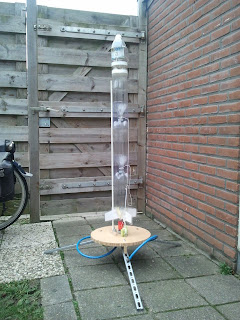I Chose to use a "Robinson coupling" to splice the bottles, this is probably the easiest way to connect bottles. A Robinson coupling consists of a hollow threaded tube that joins the bottles together, the hollow thread allows water or air to pass from one bottle into another. "HHWRSA" has a great video on how to make a Robinson coupling: http://wrocket.hampson.net.au/?p=1081 and that is exactly the way I did it.
The recovery system is based on the side deployment mechanism from Air command water rockets but without the electronic timer and the servo, instead of them I used a so called "tommy timer" which I've taken out of a cheap wind-up toy. At the launch pad the gears of the timer are jammed by a piece of plastic wire, at liftoff the wire is pulled out and the timer starts.
The pressure vessel consists of three 1.5 liter (labeled) bottles, so the total volume will be around 4.7 liters, and it is equipped with a 9 mm gardena nozzle.
The rocket will use a 1.6 meter long external guide rod to keep it stable during the first part of the flight, by the time it leaves the guide rod the rocket should go fast enough for the fins to keep it stable. The fins will be made and attached the same way as on the sov-4-20 rocket (see:SOV-4-20 part-1).
With the great videos of the side deployment mechanism and the robinson coupling building the rocket was pretty much straightforward.
I'm looking forward to launch this rocket, but a bigger rocket needs a bigger launch pad...



Hey,
ReplyDeleteGreat Blog you have here =]
I noticed in your Robinson couplings you have used metal washers that look like they are made of a form of steel, based on an experience I have suffered with my own rockets they can rust if left wet lying around. This happened to me with one rocket and the rust deposited itself on the inner walls of the bottle, stupidly I thought nothing of it and pressure tested it the day before a planned launch, needless to say the rust had weakened the bottle so much so it exploded at just 60psi.
After this I replaced the washers in all my couplings with nylon ones which do the job without the risk of rust, the threaded tubes and nuts are brass and do not suffer the same problem.
I hope this is useful for you, keep up the great posts.
Doug
Hi Doug,
DeleteThank you for your comment.
The washers I use are also the nylon ones, but in the picture it looks like they are metal ones. The threaded tubes and nuts are metal, I don't know if they will rust. I've launched the rocket last week (update comming soon) so I'll take a look tomorrow if they are rusted. Thanks for the tip.
Arjan
This particular is usually apparently essential and moreover outstanding truth along with for sure fair-minded and moreover admittedly useful My business is looking to find in advance designed for this specific useful stuffs… Water blob
ReplyDeletei never know the use of adobe shadow until i saw this post. thank you for this! this is very helpful. Water blob
ReplyDelete